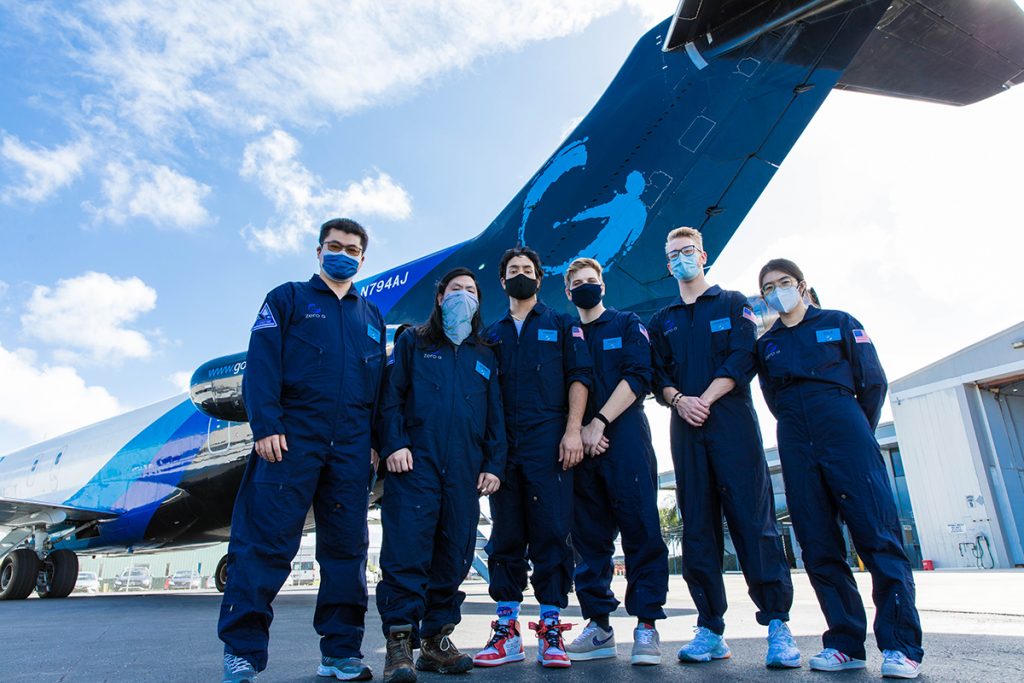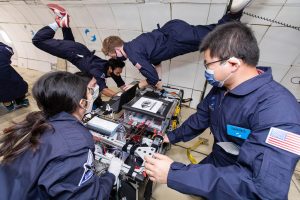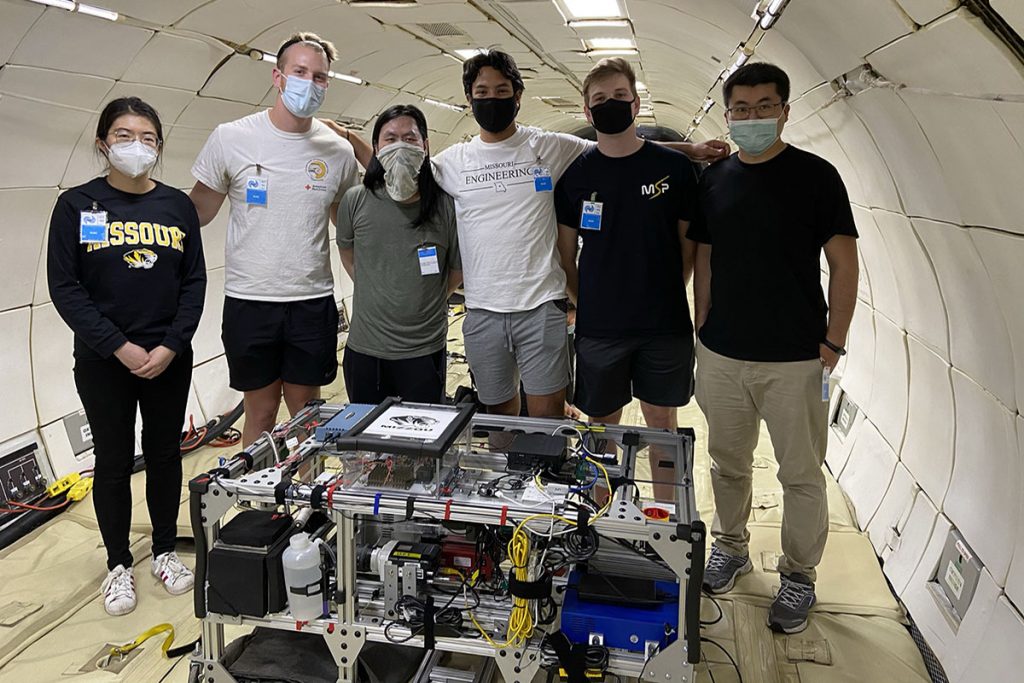December 14, 2020

The MAE research team in front of G FORCE ONE®. From left to right: Assistant Research Professor Sheng Wang, doctoral student Robin Pham, seniors Ymbar Polanco, Wyatt Fritsch, Jackson Meyer and research assistant Dr. Elle Yan.
A Mizzou Engineering team consisting of researchers and students recently performed and completed their work in a unique setting – a zero-gravity environment.
Mechanical and Aerospace Engineering Assistant Research Professor Sheng Wang and Research Assistant Elle Yan, PhD, led the team aboard the G-FORCE ONE last month at the Fort Lauderdale-Hollywood International Airport in Florida. They were joined by four Mechanical and Aerospace Engineering students: doctoral student Robin Pham, and seniors Wyatt Fritsch, Jackson Meyer and Ymbar Polanco.
Pham previously participated in the team’s first research in November 2019, along with Wang and Yan. This was the first trip for Fritsch, Meyer and Polanco.
Flight Experiences

The team conducts and observes experiments during one of the brief weightless time periods on a flight.
For the first-time fliers, experiencing zero gravity was both challenging and memorable.
“You have no idea what to expect,” Polanco said. “My body has spent 21 years with gravity, and it (zero-gravity) is a new feeling. It is breathtaking and stomach-churning at the same time.”
“This was the most extreme and rigorous change you can put your body through in a short amount of time,” Fritsch said. “They call it a ‘vomit comet’ for a reason.
“Your body has no natural response to zero gravity, and your body panics.” “You’re trying to understand how your body feels. You tell yourself ‘You’re okay. You’re okay,” but also trying to enjoy the moment,” Meyer said.
Team members who had flown in a zero-gravity environment before learned from their experience to enhance data collection methods from their previous trip.
“We added a bunch of sensors, a camera and a whole bunch of new systems to collect data versus last year,” Pham said. “We are in the zero-g environment for just a short period of time.”
The team took one flight each day for two days in Florida. Each flight contained six sessions. Every session repeated the parabola flight pattern five times. Each pattern created hypergravity lasting 60-70 seconds then followed by 17-20 seconds of zero gravity within the airplane. Hypergravity is the force of gravity twice greater than that on the Earth’s surface.
“We didn’t want to have too many manual manipulations during the experiments,” Wang said. “That’s why we automated as many processes as possible compared to the previous flight.”
“Last year’s experiences helped us adapt for this year’s trip,” Yan said. “We did some preliminary tests last year and had investigated some data, but we thought the results were not sufficient. So we improved our testing methods this time.”
Research Conducted on This Trip

The team gathers for a photo with their equipment and experiments in preparation for their flights.
The team’s research has the potential to help in space exploration missions. They are looking at ways to efficiently remove and gather water droplets that form on electronics and other solid surfaces in a zero-gravity environment. The development of this improved condensation technology, using electrowetting-on-dielectric (EWOD) methods, will have profound impacts on future deep-space NASA missions and systems, including thermal control and life support systems.
Data from the most recent flights is still being analyzed. Once finished, the team will present their findings to NASA and the public.
This follow-up research trip had been planned for March 2020. However, due to delays from COVID-19, the team was unable to take the trip until November. The team followed all university rules and regulations in planning, traveling, and conducting its research in Florida.
Suits were sanitized between each flight and everyone’s temperatures were taken before each flight.
“It was pretty unique for us to get this travel authorization at this time,” Wang said. “We had been in constant communication with College of Engineering and Mizzou leaders, NASA administrators and the flight provider Zero Gravity Corporation since June to get this trip completed. We were really careful to follow procedures during the pandemic for all the preparation work.”
The program advisor, William and Nancy Thompson Professor Chung-Lung Chen, is grateful to NASA program manager Earl Adams, College of Engineering Interim Dean Noah Manring, Vice Chancellor for Research and Economic Development Mark McIntosh, MAE Professor Zaichun (Frank) Feng, the Missouri Space Grant Consortium (MOSGC), the College of Engineering Director of Facilities Ron Monson, and Jason Huddleston for their strong support to help make this trip possible.